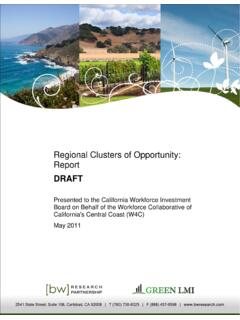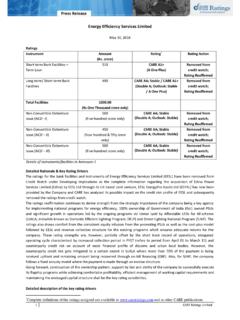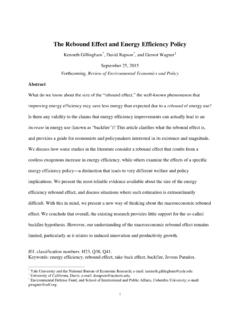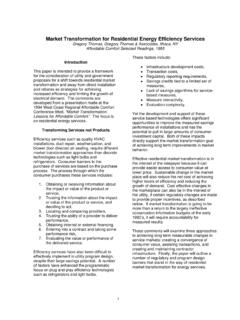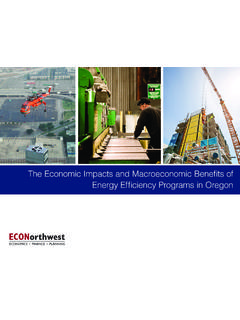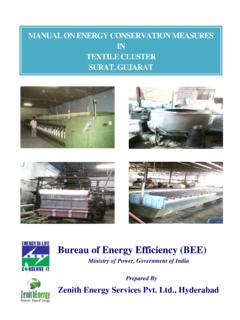Transcription of Energy Efficiency Services Sector: Workforce Education and ...
1 Energy Efficiency Services sector : Workforce Education and Training NeedsElizabeth StuartCharles A. GoldmanLawrence Berkeley National LaboratoryCalifornia Workforce Investment Board Green Collar Jobs CouncilDecember 15, 2010 The EESS is Driven by PolicyHistorically, a majority of the activity in the EESS is spurred directly and indirectly by government policies and ratepayer-funded prog & StatePrograms, Policies Codes & standards State Energy Program Weatherization assistance Enabling legislation f or perf ormance contracting in government buildings Tax credits EE R&D Rate-payer f unded ef f iciency programsEESS: Program administrators (PA), Program Implementation Contractors (PIC) Weatherization AgenciesEESS: Energy Service Companies (ESCO) Energy ConsumerBuilding Own erEESS:Building & Con stru ctionIn du stryDefining the EESSThis study includes the portion of the EESS market supply chain that focuses on deployment and installation of Energy Efficiency products and measures.
2 Within this, we further limit our scope to those EE products and Services whose demand is driven primarilyby the Energy savings. Commercial-Institutional EESSE nergy Efficiency Services sector Workforce Size:Current and projected levels of employment in PYEE nergy Efficiency Services sector Workforce Size:Current and projected levels of individuals employedEESS Workforce SizeCurrent Size: 114,000 person-years of employment (PYE) Approximately 380,000 individuals employed Projected Size in 2020: Approximately 400,000 PYE (high-growth scenario) Up to million individuals employed A projected 2-fold (low-growth scenario) to 4-fold (high-growth scenario) increase in employment by 2020 Key Challenges for EESS Workforce Growth Shortage of management-level applicants with experience in Energy Efficiency Shortage of experienced Energy Efficiency engineers Building and construction industry.
3 Limited awareness that the EESS is poised to expand significantly and their skills will be required Retirement is a growing concern Limited number of skilled trainers for EEEnough Engineers? Few engineers enter the field with EE experience The demand for engineers with knowledge of Efficiency is currently met by hiring other types of engineers and training them on the job Many industries compete for engineering talent, and engineers often do not know the EESS field exists The most likely source for new EESS engineers is to transition engineers from other fields into energ y Efficiency . But until energ y engineering is recognized as an engineering discipline this may be Engineers for Program Administrators and Implementation ContractorsEnough Managers? The primary limitation on implementation contractor firm growth, or expanded program offerings for some administrators, is the lack of management-level applicants with EE experience Experienced managers are vital mentors for the next generation of managers and staff30% of survey respondents indicated that it is as difficult to find experienced EE managers as engineering talent.
4 Difficulty Hiring? Managers and engineers with experience in Energy Efficiency especially difficult to find Filling experienced positions often occurs by hiring from other firms Labor union respondents also report some difficulty recruiting qualified applicants into apprenticeship programsRespondents believe there are challenges hiring into the EESS for ANY position other than entry in hiring for the 8 Efficiency -specific occupations in Variety of EE Trainings are Emerging and Growing Residential Energy Services Network (RESNET) Weatherization Assistance Program (WAP) Association of Energy Engineers (AEE) Building Performance Institute (BPI) Association of Energy Services Professionals (AESP) Some community colleges Some four-year programs Union apprentice programs (though EE-specific curriculum appears limited)Recommendations EE Workforce Education and Development as separate programmatic element in EE program plans Conduct EE Workforce Training & Needs Assessment Target EE training for the Trades (65-70% of EESS Workforce ) Increase short-duration, applied trainings on EE topics to augment on-the-job training Increase funding to train the trainers Growth rates strain current capacity.
5 Lack of qualified trainers likely in future Prepare the next generation of EESS Professionals Few colleges offer EE-specific curriculum Universities/colleges: Develop building science centers and EE policy/planning centers New tool on horizon: Workforce Guidelines for Home Energy Retrofits Voluntary quality standards for certification and training programsContactCharles Goldman/Elizabeth StuartLawrence Berkeley National LaboratoryEmail: 510-486-4637 Energy Efficiency Services sector : Workforce Education and Training SlidesJobs per $1M SpendingActivityPerson-Years of Employment (PYE) per $1 MRatepayer-funded Efficiency Income Service Companies (ESCOs) and State Govt EERE TypePerson-Years of Employment (PYE) per $MUMASS-PERI and (2008)Green Jobs (direct) (2004) Energy (2008) Energy Efficiency ( premium Efficiency ) (2007) Energy Efficiency (direct) Energy Fund (2009) Energy results compared to other studiesResidential EESSB reakdown of Current Jobs~55% of current PYE Trades people and professionals responsible for building envelope insulation and mechanical insulation~30% of current PYE - Rate payer-funded Energy Efficiency efforts, including the staffs of program administrators, implementation contractors.
6 As well as the building and construction professionals and trades people that design and install the equipment leveraged by ratepayer-funded programs~10% of current PYE -ESCO efforts, including ESCO staff and the contractors they hire among the building and construction industry~5%of current PYE Weatherization assistance efforts of the federal and state governmentsReady for Growth? Pgm. Administrators estimated that their staff will grow ~19% by 2010 Implementation Contractors estimated that their staff will grow ~64% by 2010 In contrast, less than 50% of 160 respondents that represented building and construction industry associations and trades could even estimate the percent of the current Workforce that was involved in EERelatively low level of awareness in the building and construction industry about growth potential in the EESSThe influence of Energy Efficiency on the building Workforce ?
7 Retirement is not currently a concern for program administrators or implementation contractors; however, the building and construction industry is facing substantial changes in the Workforce due to retirements between 2015 and 2025 Percent of staff likely to retire in next 5 years: Program Administrators Minor issue for some (~15%) Implementation Contractors & Program Support Contractors Not an issue (~5%) ESCOs Not an issue (~5%) Building and Construction Industry Growing concern (>35%)Building Industry Workforce Older than 50 Transforming Existing JobsTwo primary paths for entering the EESS Workforce : Existing occupations ( , HVAC technicians, lighting contractors, construction trades, project managers) which are transformedinto more Energy Efficiency -focused positions via retraining Emerging occupations that are somewhat unique to the EESS ( , home Energy raters, commissioning Services , Energy /home performance Services , Energy auditors)Many jobs in the EESS are not new jobs, but rather jobs that need to evolve to provide more Energy efficient versions of current (and future) products and Services .



